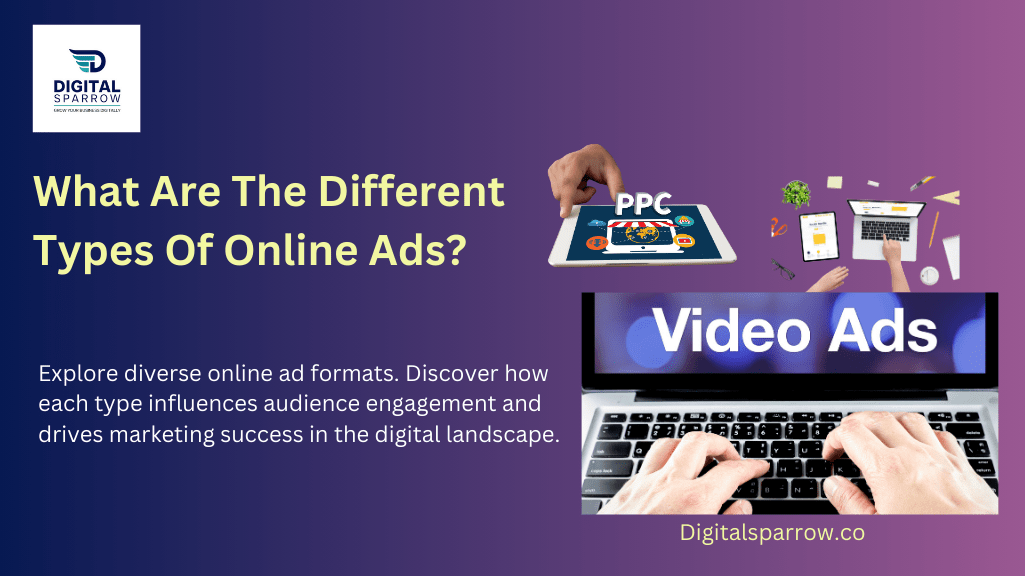1. Introduction
Online advertising has changed the way firms reach out to their target audiences. New sorts of online ads arise as the digital landscape evolves, offering marketers increasingly sophisticated methods to communicate with potential customers. In this complete guide, we’ll delve into the world of internet advertising, looking at different ad formats, strategies, and upcoming trends.
The Evolution of Advertising in the Digital Age
Since the Mad Men era of television and print advertising, advertising has come a long way. Online advertising has become a driving factor in how organisations communicate with their target audiences in today’s digital world. Because of the internet’s pervasiveness and accessibility, marketing methods have been revolutionised, and online advertising has become a must-have for organisations of all sizes.
The Significance of Online Advertising
Online advertising offers unparalleled advantages, such as global reach, precise targeting, real-time tracking, and cost-effectiveness. As a result, businesses can tailor their messages to specific demographics, analyse ad performance in real-time, and optimise campaigns for maximum impact. This guide will explore the diverse types of online ads available, each with its own unique strengths and applications.
2. Display Advertising
Display advertising involves visually appealing ads placed on websites, apps, or social media platforms to capture the audience’s attention. It encompasses several formats:
Banner Ads
Banner ads are rectangular or square visual ads that typically appear at the top, bottom, or sides of webpages. They can be static or animated and are a common sight on websites. Banner ads aim to grab the viewer’s attention quickly.
Rich Media Ads
Rich media ads go beyond static visuals, offering interactivity and engagement. These ads can include animations, video, audio, and interactive elements, enhancing user engagement and message delivery.
Video Ads
Video commercials, as the name implies, use video content to convey messages. They can appear before (pre-roll), during (mid-roll), or after (post-roll) web videos. Video advertisements are extremely successful in telling stories and conveying complex information.
Native Ads
Native ads seamlessly blend into their environment, matching the content and style of the platform where they appear. They are less intrusive and more likely to engage users by providing value within the context of the content they’re viewing.
3. Search Engine Marketing (SEM)
Search Engine Marketing (SEM) involves paid advertising on search engines, primarily through pay-per-click (PPC) campaigns. SEM ensures that your ads appear prominently in search results when users enter specific keywords.
Paid Search Ads (PPC)
Paid search ads: businesses can bid on terms related to their products or services, which are commonly listed at the top of search engine results pages. Advertisers only pay when users click on their advertisements, making it a cost-effective approach to targeting potential buyers who are actively searching for comparable offers.
Shopping Ads
Shopping ads, commonly seen on platforms like Google Shopping, display product images, prices, and store information. They are ideal for e-commerce businesses looking to showcase their products directly within search results.
Local Search Ads
Local search ads target users searching for nearby businesses or services. They often include location information and are effective for brick-and-mortar businesses seeking to attract local customers.
4. Social Media Advertising
Social media advertising allows businesses to reach their target audiences on popular social platforms. Each major social media platform offers its own advertising solutions:
Facebook Ads
Facebook provides a variety of ad forms, including image advertisements, video ads, carousel ads, and more. Advertisers may accurately target consumers based on demographics, interests, and behaviour.
Instagram Ads
As a subsidiary of Facebook, Instagram provides a visually focused advertising platform. Businesses can use photo and video ads to connect with Instagram’s vast user base.
Twitter Ads
Twitter advertisements allow businesses to promote tweets, accounts, or trends in order to engage people in real-time dialogues. Promoted tweets may display in users’ timelines and search results.
LinkedIn Ads
LinkedIn is a professional networking platform, making it ideal for B2B advertising. Advertisers can target professionals based on job titles, industries, and company size.
Pinterest Ads
Pinterest is a visual discovery site that is ideal for businesses that have aesthetically appealing products. Promoted pins merge in with user-generated content seamlessly.
Snapchat Ads
Snapchat ads leverage multimedia content, including images and short videos, to reach a younger demographic. They offer engaging ad formats like AR lenses and filters.
How to Attract and Convert Your Competitor’s Audience
5. Email Marketing
Email marketing involves sending promotional messages or advertisements to a list of subscribers. While it’s an older form of digital marketing, it remains highly effective when executed correctly.
Email Newsletter Ads
Email newsletters frequently incorporate advertisements or sponsored content in addition to useful information or updates. These advertisements are sent to subscribers who have previously demonstrated an interest in the sender’s offerings.
Sponsored Emails
Sponsored emails entail collaborating with another brand to market their products or services to your email list. When both brands have a comparable target audience, this might be a win-win strategy.
6. Affiliate Marketing
Affiliate marketing is a performance-based advertising strategy where businesses reward affiliates (partners) for driving traffic or sales to their website. It involves two primary components:
Affiliate Links
Affiliate links feature unique tracking tags that identify the affiliate responsible for delivering traffic. Affiliates earn a commission for each sale or action generated through these links.
Affiliate Networks
Affiliate networks act as intermediaries, connecting businesses with potential affiliates. They provide tracking, reporting, and payment solutions, simplifying the affiliate marketing process.
7. Content Marketing
Content marketing focuses on creating valuable, informative, or entertaining content to attract and engage target audiences. It can be a powerful complement to various online advertising strategies.
Sponsored Content
Sponsored content involves working with publishers or influencers to develop and distribute material that promotes your products or services. This information frequently appears in a seamless manner within the publisher’s platform.
Influencer Marketing
Influencer marketing makes use of the popularity and reputation of social media influencers, bloggers, or vloggers to promote businesses or services. Influencers share their experiences with your services with their loyal following.
8. Mobile Advertising
Mobile advertising targets users on smartphones and tablets, capitalising on the ubiquity of mobile devices. It includes various ad formats tailored for mobile consumption.
In-App Ads
In-app advertising displays within mobile applications and games, giving advertisers the opportunity to reach people while they interact with content.
Mobile Web Ads
Mobile web ads display on websites optimised for mobile devices. These can include banner ads, interstitials, and native ads.
Location-Based Ads
Location-based advertisements use a user’s geographic location to deliver relevant marketing. They are extremely successful for firms with physical stores.

9. Video Advertising
Video advertising taps into the popularity of online videos, delivering ads to users before, during, or after video content. It offers engaging storytelling opportunities.
Pre-roll Ads
Pre-roll ads appear before the main video content and typically last from a few seconds to a minute. They are a typical format on platforms such as YouTube.
Mid-roll Ads
Mid-roll advertisements appear in the middle of longer video content, such as online TV episodes or livestreams. They interrupt the video in the same way that TV ads do.
Post-roll Ads
Post-roll ads play after the main video content. They are less common but can still capture viewers’ attention.
Overlays
Video overlays are transparent ads that appear on top of video content, often displaying additional information or calls to action.
10. Programmatic Advertising
Programmatic advertising automates the buying and placement of digital ads, optimising campaigns in real-time. It includes two main methods:
Real-Time Bidding (RTB)
RTB involves buying and selling ad impressions in real-time through automated auctions. Advertisers bid for the right to display ads to specific users.
Programmatic Direct
Programmatic direct deals involve direct negotiations between advertisers and publishers to secure ad placements, ensuring brand safety and control.
11. Remarketing/Retargeting
Remarketing or retargeting aims to re-engage users who have previously interacted with a website or app but did not complete a desired action, such as making a purchase.
Ad Retargeting
Ad retargeting shows advertising to visitors who have previously visited a website or browsed specific products. These ads remind viewers of previous interactions and encourage them to return.
Email Retargeting
Email retargeting involves delivering personalised emails to consumers who have abandoned shopping carts or visited specific pages on a website. These communications may feature product recommendations or discounts.
12. Native Advertising
Native advertising integrates into the user experience by matching the shape and function of the platform on which it appears.
In-Feed Native Ads
In-feed native ads mimic the style and content of a platform’s regular feed, appearing as sponsored posts within social media or content feeds.
Recommended Content Widgets
Recommended content widgets, which are commonly found at the conclusion of articles or content pages, propose related articles or goods within a website or app.
13. Audio Advertising
Audio advertising targets users through audio platforms and streaming services, capitalising on the popularity of podcasts and music streaming.
Podcast Ads
Podcast ads are promotional messages featured in podcasts to promote products or services. They help podcast creators monetize their content while providing advertisers with a targeted audience.
Streaming Music Ads
Streaming music providers provide audio and visual commercials to free-tier customers, enabling chances for audio and video advertising.
14. Interactive Advertising
Users are engaged when they are invited to interact with ad content, resulting in memorable and engaging experiences.
Interactive Display Ads
Interactive display ads encourage users to engage with elements like sliders, quizzes, or games within the ad unit.
Gamified Ads
Gamified ads turn ads into mini-games, rewarding users for participation and interaction with the brand.
15. Influencer Marketing
Influencer marketing leverages the influence and reach of individuals on social media or in specific niches to promote products or services.
Social Media Influencers
Social media influencers have a large number of loyal followers and may honestly recommend products or services to their audience.
Bloggers and Vloggers
Bloggers and vloggers create content around a specific niche or interest,making them excellent partners for marketers looking to reach a specific audience.
16. Emerging Trends in Online Advertising
Online advertising is a dynamic field that is constantly evolving to adapt to new technologies and consumer behaviours. Here are some emerging trends:
Augmented Reality (AR) Ads
AR advertisements enable people to interact with items or brand experiences in their natural surroundings, increasing engagement and product visualisation.
Virtual Reality (VR) Ads
VR ads provide immersive experiences within virtual environments, offering unique opportunities for storytelling and brand engagement.
Voice Search Advertising
With the rise of speech-activated devices, voice search advertising optimises content for voice search queries, giving audio answers or sponsored results.
AI-Generated Content
Artificial intelligence (AI) can generate personalised ad content, from product recommendations to dynamic ad creatives tailored to individual users.
WHY YOU NEED A MARKETING PLAN?
Conclusion
Businesses have a wide range of opportunities to interact with their target customers through online advertising. Your objectives, target market, and financial constraints will all influence the kind of online advertising you choose. Additionally, tracking the results of your internet marketing activities is essential for improving your campaigns and boosting your ROI.


Pingback: Boost Interior Designer Business Leads with Google Ads
Thanks for sharing. I read many of your blog posts, cool, your blog is very good.
Your point of view caught my eye and was very interesting. Thanks. I have a question for you.
Your article helped me a lot, is there any more related content? Thanks!
Bottega Veneta 作為奢侈品牌的代表,以其簡約精致的設計風格和精湛的皮具工藝著稱。bv哪裏買最便宜?
無論是搭配休閑裝還是正裝,Nike dunk鞋都能輕松駕馭,展現出不同的風格魅力。nike dunk哪裡買最便宜?
the Best Vape Shopvape shop
電子煙:品質、潮流 iqos 電子煙
Aape:潮流青春碰撞 bape推薦
Can you be more specific about the content of your article? After reading it, I still have some doubts. Hope you can help me.
Hey everyone! Stop for a moment to count the little things in life. The little moments are often the most significant blessings.